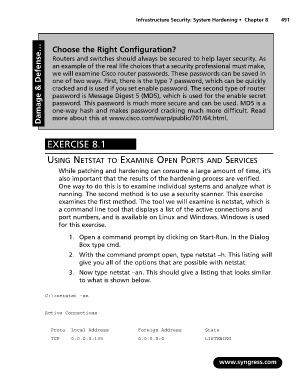Page 507 - StudyBook.pdf
P. 507
Infrastructure Security: System Hardening • Chapter 8 491
Damage & Defense… Routers and switches should always be secured to help layer security. As
Choose the Right Configuration?
an example of the real life choices that a security professional must make,
we will examine Cisco router passwords. These passwords can be saved in
one of two ways. First, there is the type 7 password, which can be quickly
cracked and is used if you set enable password. The second type of router
password is Message Digest 5 (MD5), which is used for the enable secret
password. This password is much more secure and can be used. MD5 is a
one-way hash and makes password cracking much more difficult. Read
more about this at www.cisco.com/warp/public/701/64.html.
EXERCISE 8.1
USING NETSTAT TO EXAMINE OPEN PORTS AND SERVICES
While patching and hardening can consume a large amount of time, it’s
also important that the results of the hardening process are verified.
One way to do this is to examine individual systems and analyze what is
running. The second method is to use a security scanner. This exercise
examines the first method. The tool we will examine is netstat, which is
a command line tool that displays a list of the active connections and
port numbers, and is available on Linux and Windows. Windows is used
for this exercise.
1. Open a command prompt by clicking on Start-Run. In the Dialog
Box type cmd.
2. With the command prompt open, type netstat –h. This listing will
give you all of the options that are possible with netstat.
3. Now type netstat –an. This should give a listing that looks similar
to what is shown below.
C:\>netstat -an
Active Connections
Proto Local Address Foreign Address State
TCP 0.0.0.0:135 0.0.0.0:0 LISTENING
www.syngress.com

